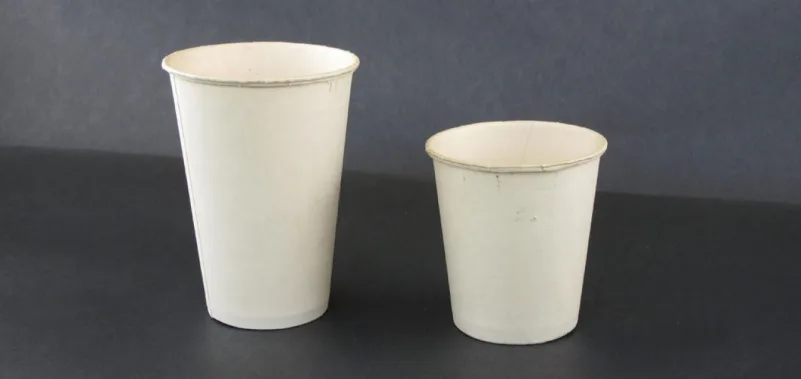An Environmental Backlash

Cartoon by Tom Engelhardt. “I guess it was inevitable in this throwaway age,” St. Louis Post-Dispatch, 18 November 1988.
Throughout the 1980s, nearly every industry faced social pressure to clean up its act–literally. Consumers began to consider the toll that the objects they used took on the environment. As one editorial writer pointed out, disposable items might be cheap, but they were costly in other ways: “During World War II there were virtually no throwaways. Householders saved tin cans, grease from cooking, used tires, and even the tinfoil from cigarette packs. It all went into the war effort. Now we should revert to similar frugality to battle pollution, which in time could be more costly–in health and lives–than all our wars.” Increasingly, consumers looked for products that not only satisfied their budgets and practical needs, but also their environmental conscience.
Some early manufacturers of disposable cameras like Beaurline and Technicolor had produced reusable cameras with the goal of reducing manufacturing costs rather than meeting environmental concerns. There was little motivation for camera companies to recycle parts that could not be reused, and one can easily imagine a landfill stacked high with Loves. When a plastics company announced it was considering developing a “use it, chuck it” camera in 1971 (a year after the first Earth Day), a New York man wrote in to Popular Mechanics, declaring, “I am very much against the ‘New Disposable Camera.’ These new cameras will just be adding to the tons of waste and garbage on the Earth.” With the introduction of modern disposable cameras in 1987, more consumers expressed similar sentiments. They demanded to know, “Where are all the disposable camera carcasses going after they have been used once and then pitched?” The answer wasn’t pretty.
The original Quicksnaps and Flings were sonically welded together, which required them to be destroyed for the film to be extracted. Camera companies could have recycled the destroyed plastic parts, but that would have meant additional costs. Consequently most single-use cameras ended their lives in landfills. As a result of these practices, by 1988 manufacturers were experiencing a backlash. Environmental organizations singled out disposable cameras as being particularly offensive. Government officials joined them, and in 1989 Kodak mockingly received a “Waste Maker of the Year” award from a US senator.
Mother Kodak Embraces Mother Earth
“Mother Kodak” responded by revamping the image of its products. When the company had introduced disposables to the United States in 1987, spokespeople liberally used the term “disposable.” In 1989, however, Kodak made the switch from “disposable camera” to the more environmentally-friendly sounding “single-use camera,” and changed the name of the Fling to the Funsaver. The following year the company introduced a recycling program. Fuji rolled a similar program out a month later, in June 1990.

A worker at Kodak’s recycling center in Rochester sorts returned disposable cameras. Popular Photography, September 1994.
Central to these programs was the incentive–five cents per camera–provided to photofinishers for returning the cameras they developed to the manufacturer. Kodak paid for shipping to a recycling facility in Rochester, NY, where the cameras would be inspected and disassembled. New cameras were built from disassembled parts. For example, the plastic bodies of the cameras could be reused six times, and the flash circuits ten times. Plastic components that could not be reused were grounded down into reusable pellets. Cardboard labels were burned in an incinerator and used to provide manufacturing facilities with energy. Kodak also donated partially-used batteries to United Way. Fuji’s recycling program was, in comparison, underwhelming; only the plastic case was reused, the rest being ground down. Nevertheless, the recycling programs were deemed successes. By 1994, the majority of cameras were finding their way back to their manufacturer for reuse and recycling.
In order for recycling programs to be sustained over the long term, newly introduced cameras had to be compatible with existing products. Accordingly, although to different degrees, Kodak and Fuji embraced the principles of design for environment. Engineers at Kodak designed the successor to the FunSaver, the Kodak Max, so that it could be assembled with parts from reclaimed Funsavers. As a result, by weight 86 percent of the Max, which debuted in 1995, could be reused. While the adoption of this engineering strategy meant Kodak was saving millions in manufacturing costs, it also meant placing restrictions on the innovations engineers could introduce to the design. Fuji, by comparison, placed more emphasis on innovation than reusability. Even so, its cameras consisted of 75 percent reusable parts. Kodak and Fuji were proud of these numbers, and made their efforts known to customers, displacing the image of a mountains of plastic cameras in a landfill with the image of new cameras being rebuilt from old parts. In so doing, they added a new dimension to the disposable camera’s appeal. Consumers made it known that they wanted disposable cameras that were cheap, convenient, satisfactory in quality, and environmentally responsible. Kodak and Fuji answered their call.

Chart explaining to consumers how Kodak reuses and rebuilds disposable cameras. Kodak EnviroNotes brochure, 1991.
1 2 3 4 5
